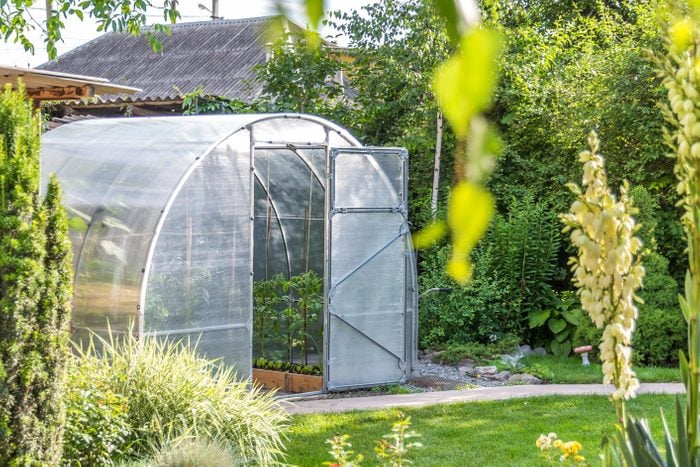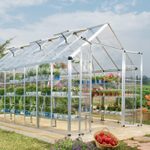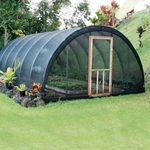9 Types of Greenhouses

In a greenhouse, you can use your green thumb all year. Choose the type of greenhouse that suits your yard, and your gardening dreams can come true.
Our editors and experts handpick every product we feature. We may earn a commission from your purchases.
Nestled on a peninsula on the central California coast, the small town of Half Moon Bay is a mecca for surfers in the winter months. But it’s a year-round destination for another reason — a long row of greenhouses crowded with locals and tourists. These provide the region with exotic flowers, medicinal herbs, fruit trees, succulents, vegetables and many other plants.
Every community has its share of greenhouses, but few are clustered in one place like the ones at Half Moon Bay. In a greenhouse, you can get a jump on the growing season by planting seeds several weeks before the soil warms, and grow plants to maturity that wouldn’t otherwise survive in your climate.
If this makes your green thumb tingle with anticipation, know there are so many greenhouse options that you’ll undoubtedly find one that will work for you, no matter where you live. There are even small greenhouses that can be set up on the balcony of an apartment building!
Whether you want a steady supply of sprouts, peas or lettuce for your dinner table, poinsettias for Christmas, or sage, thyme and cilantro to amp up your cooking, here’s some background about the most common types of residential greenhouses.
On This Page
What Is a Greenhouse?
It’s right there in the name: A greenhouse is a structure where vegetation grows inside. It provides an ideal environment to magnify or reduce sunlight as needed, control temperature and irrigate more efficiently. Greenhouse gardening is rarely as simple as tossing up a structure and bringing in plants.
Transparent roofing and insulating walls, controlled ventilation and easy access to water make all this possible. Not all greenhouses amplify light. Some provide shade to protect plants that can’t tolerate full sun and high temperatures. And some incorporate sunny and shady zones so a diverse ecosystem can flourish.
Types of Greenhouse Materials
Although there’s no reason a greenhouse can’t have a structure as strong as a house (and some do), most have rudimentary frames made of metal pipe, plastic pipe or wood.
- Plastic piping is the least expensive material, but lacks the rigidity needed for a large structure.
- Wood is a good thermal insulator, important in cold climates.
- Metal piping (aluminum or steel) is long-lasting and durable, but it isn’t a good insulator. Especially aluminum.
Large greenhouses often have well-insulated glass walls and roofs. But clear polycarbonate, acrylic and fiberglass also work, especially for smaller structures.
- Glass is the traditional greenhouse material. It’s expensive, difficult to install and can crack. But it insulates well, looks best and transmits light the best. Browse our top picks for glass greenhouses.
- Acrylic is also expensive, but it’s long-lasting and, unlike glass, can be bent and molded (to a degree) to fit a curved frame.
- Polycarbonate is a strong and lightweight material and budget-friendly compared to glass and acrylic. It’s available as flexible sheeting and tends to diffuse light rather than transmit it directly.
- Fiberglass is the least expensive greenhouse material. It works well in extreme climates and is almost as transparent as glass when it’s new. But it tends to turn yellow over time and reduce light transmission.
Types of Greenhouse Structures
Greenhouses can be freestanding or connected to a building or another greenhouse. Some structures are more appropriate for large-scale growing, while others work best when space is limited. Here are the options:
Gable-style
The traditional gable construction, with straight walls and sloping roofs that create a triangular gable on either end of the structure, works well for a greenhouse. It’s the most common design, providing plenty of sun and room to move inside. It’s easy to build it works as well for large greenhouses as well as small ones that fit on a porch or veranda.
A-frame
Similar to a gable-style structure and even easier to build, an A-frame has long sloped roofs that extend all the way to the ground. An A-frame maximizes light, but space and airflow are limited underneath the parts of the roof close to the ground. A-frames tend to be better for storage than growing.
Geodesic dome
A geodesic dome is an incredibly strong structure that holds up well in severe weather conditions and looks really cool!
You can make your own frame by mass-producing sticks or rods of the same length and assembling them with connectors in a series of triangles. But most people will purchase a kit that includes everything you need. Even so, assembly is more complicated than other structures.
Psst! Check out this portable greenhouse, too.
Gothic arch
A gothic arch is something of a hybrid of gable-style and A-frame. The walls are framed with aluminum or steel poles that curve gracefully to join with a ridge cap and form a pointed roof, reminiscent of a medieval cathedral.
It’s a strong structure that easily sheds snow and rain. It’s easy to assemble and arguably the most elegant type of greenhouse. The curves necessitate a flexible covering, such as polycarbonate film.
Hoop house
Constructed from a series of semi-circular hoops, the hoop house is an easy-to-construct structure. You attach the ends of the hoops to base plates or stick them into the ground, and they automatically form the supports for the walls and roof.
Hoop structures are ideal for covering long rows, and they provide more room near the walls than in an A-frame structure. They must be covered with something flexible like polycarbonate film, and don’t shed snow and water as well as other structures.
Saw tooth
The saw tooth design can be similar to a gable, or it can have an arched roof and sides similar to a hoop house. The roof on one side is higher than the other, creating a space for windows that can be opened to provide extra ventilation.
Uneven span
When building a greenhouse on sloped land, an uneven span is often the most efficient design. It’s a variation of the gable design, with one side of the roof — usually south-facing — much longer than the other to maximize light intake.
Lean-to
The lean-to is built onto the wall of an existing structure and slopes away from it, preferably southerly. This simple design is ideal for urban properties with little space. Even though the side facing the building is dark, radiating heat warms the greenhouse, and the building adds stability.
Abutting
Similar to a lean-to, an abutting greenhouse attaches to an existing structure. But the building wall forms one of the ends of the greenhouse, not a wall. When built in front of a door, the greenhouse can double as a sunroom.
Bonus: Mini window greenhouse.



